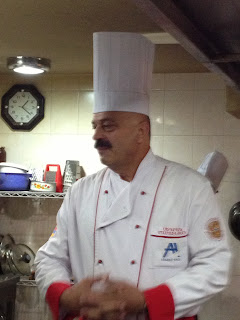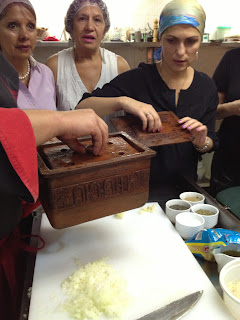 |
| Chef Mamulyan |
Background: In the Soviet era all restaurants were government-owned and no ethnic pride in foods was permitted. Food was pretty bland. So after independence 21 years ago Chef Mamulyan started by going door-to-door, asking people for their family recipes, explaining his hopes for reviving true Armenian cuisine. Ararat Hall is his lab and his pride.
 |
| Annie, Achkhen, Wilma, Armine, Rilla, Gohar, Libby, Flora (whose son owns the butcher shop next door) |
 |
| One of the prep trays |
 |
| A kitchen minion had prepared our grape leaves |
 |
| Gohar watching Chef #2 saute onions for dolma |
The veggie dolmas were placed in a square clay pot with a removable, perforated bottom and a perforated "weight" layer as well as a lid. They were then covered with water and steamed in the oven. Several of us took advantage of the chef's connection who will sell us one of these bakers for 15,000 AMD (about $35) each. They are beautiful and practical and could be used for any number of things for generations.
 |
| Lamb chop-stuffed cabbage ready to bake |
 |
| Ready to roll |
 |
| Minced onions waiting for garlic |
 |
| Sultanas in butter with cherry puree |
I finally got to see what Armenian cooks do with the big ropes of what looks like herbs I see in the market. Not herbs, but dark greens (think kale), dried. First they are boiled to a fare-thee-well. The water is drained and they are reboiled (to get bitterness out) and then drained well and put in a large skillet with the tried and true garlic and walnut paste, some minced lamb fat, and then loaded up with fresh pomegranate seeds (you have to love a country that loves pomegranates!). The dish was then garnished with baked lavash chips (Have stale lavash? Sprinkle it with salt and pepper and bake it til it is crisp.)
 |
| Looking a little peaked |
 |
| Greens with pomegranate in foregournd |
 |
| A welcome form our host |
 |
| Ambassador John toasting our host |
 |
| Wilma, Flora & Armine with the claycooker |
The overarching value of this experience--which had many parts--for me was the feeling of connection with the other women, feeling grateful for their generosity in translating for me, for being able to get to know them better. I walked out feeling very full indeed. Priceless.

No comments:
Post a Comment